The views expressed in this post are those of the author and not necessarily those of Open Nuclear Network or any other agency, institution or partner.
* The article was originally published on ONN's Datayo platform.
Throughout the month of June, North Korea has shown increased hostility toward South Korea. Some of these efforts include re-installing loudspeakers along the Demilitarised Zone at one point before removing them, blowing up a joint liaison office in its territory and announcing plans for a massive anti-South Korea leafleting.
What sparked the dramatic response from the North has a two-part explanation. First, the near-term and more obvious answer is the leafleting by defectors into the North.
Second, given that leafleting from both sides of the border has been going on since before the 1953 Korean Armistice Agreement, one cannot discount the fact that North Korea is using the leafleting as an opportunity to artificially ramp up tensions on the Korean Peninsula. It can serve multiple purposes such as adding weight to Kim Yo Jong's position as the right hand to its leader Kim Jong Un, seeking more concessions on the international arena and to distract its people from the worsening economic situation. Kim Yo Jong is the first vice director of the United Front Department of the Workers' Party of Korea (WPK) and the younger sister to North Korea's leader.
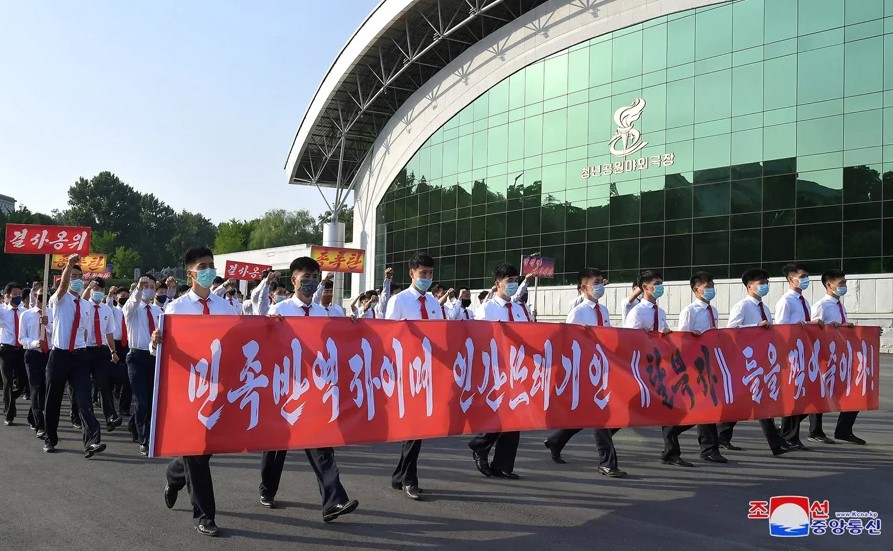
North Korean students holding anti-defector signs in Pyongyang. Source: KCNA
Messages in Bottles
Leafleting is a method used around the globe to disseminate written or visual information. In the context of inter-Korean psychological warfare, they contain promotion of one's own regime and the criticism of the other regime, especially of the opposing leadership. In this brief, we mainly explore the leafleting efforts made by private defector-led organisations.
While government loudspeakers or foreign broadcasting to North Korea cover a wide range of topics such as news reporting on world affairs to entertainment including American and South Korean pop music, privately distributed leaflets from the South Korean side of the border have a specific main subject - the Kim family. One of the most recent leaflets sent to the North covers the death of Kim Jong Un's half brother Kim Jong Nam in Malaysia. Other topics include South Korea’s economic prowess and Christianity. The language is much stronger than typical loudspeaker broadcasts also, calling Kim a "human butcher", for instance.
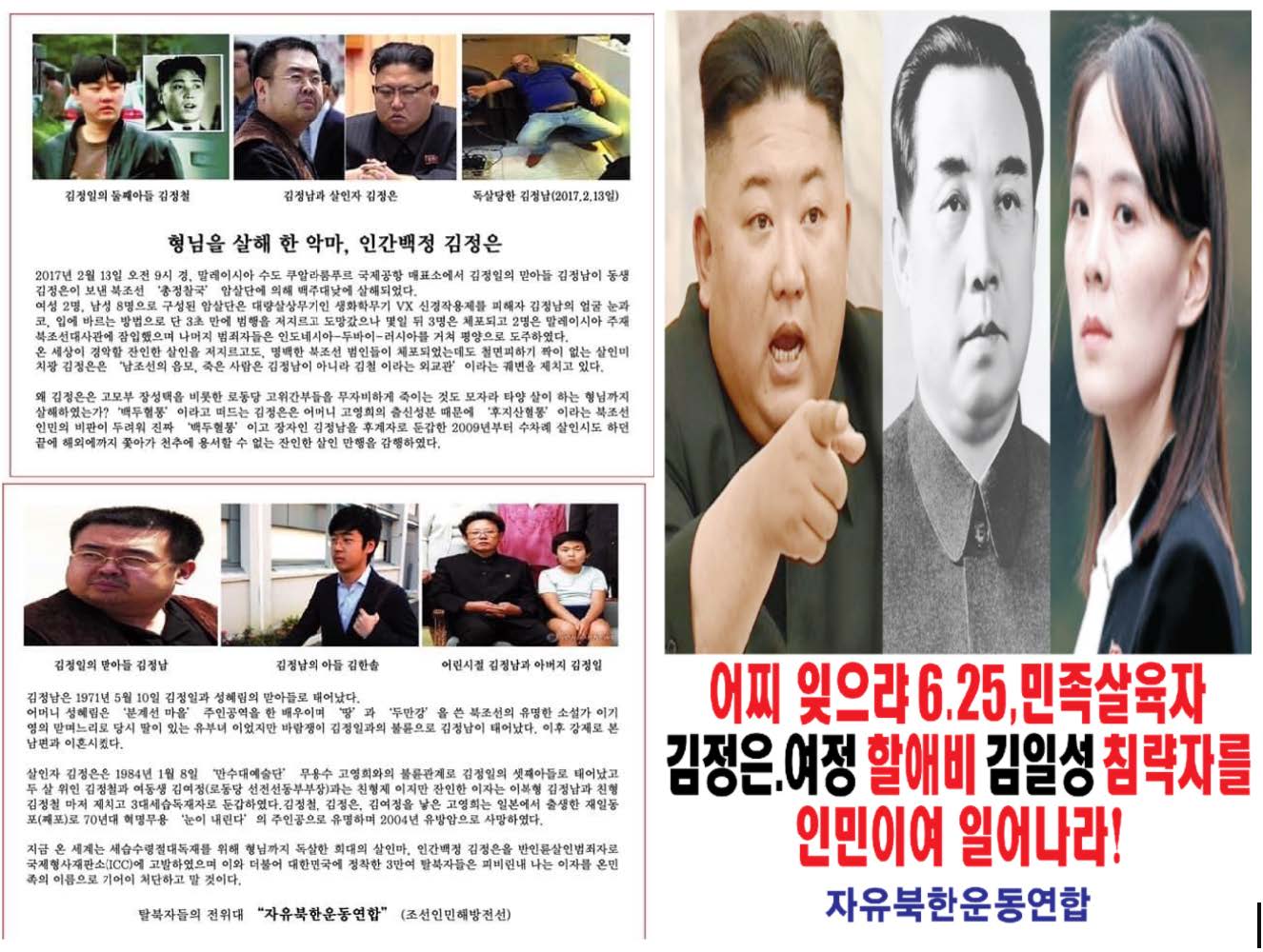
The two most recent leaflets launched by The Fighters for a Free North Korea with texts about the Kim family. Source: FFNK
The Evolving Faces behind Leafleting
There are two different types of leafleting activities. The more traditional way is a stealth operation of launching balloons filled with leaflets and incentives such as dry rice and or money in the middle of the night - depending on the weather condition and without informing the press. Recently, there has been more attention to leafleting activities by private organisations in South Korea due to social media pushes to showcase efforts to donors.
While the correct term for such activities is leaflet dropping (전단살포) in Korean, it is also commonly referred to as "bbira", especially by the older generation. It is a Japanese adaptation of the English word "bill" that made its way into the Korean language.
Media outlets are currently highlighting two organisations run by North Korean defectors Park Sang-hak and Park Jung-ho, who are brothers. Sang-hak, the elder brother, is the founder and executive director of The Fighters for a Free North Korea (FFNK or 자유북한운동연합) that focuses on balloon launches. The younger brother Jung-ho is the director of Kuen Saem (큰샘,) which covers the seaborne campaign.
The Park brothers' organisations have been launching such leaflets into North Korea some eight to 15 times a year since 2004. Per launch, the standard leaflet count is 500,000.
An older leafleting organisation named "Campaign for Helping North Korean in Direct Way (북한동포직접돕기운동)" is led by Lee Min-bok, who lives along the DMZ border. Also a defector, Lee has been launching leafleting campaigns since 2001. Unlike the Park brothers, however, Lee is unlikely to face a legal action by the government as his group operates in the dark and unannounced to the media and the general public.
The South Korean Unification Ministry [1] announced on 13 June, it requested the Seoul Metropolitan Police investigate the Park brothers' organisations. Investigation requests are made on multiple accounts, namely: violation of a law governing inter-Korean exchanges and cooperation by sending unauthorised materials to North Korea, violation of the Public Waters Management and Reclamation Act, as well as violation of the aviation security law. If found guilty, the organisations can lose their legal status.
More than Words
Inside a typical double-sided leaflet, one will find one dollar bills in the total amount of $2,000 per launch, provided to the activist organisations mostly by Korean-American donors. Previously, human rights activist groups have included CDs and USB sticks inside plastic bottles filled with shortgrain rice, a staple in Korean diet. Other typically included items are female hygiene products, antiparasitics and the Bible.
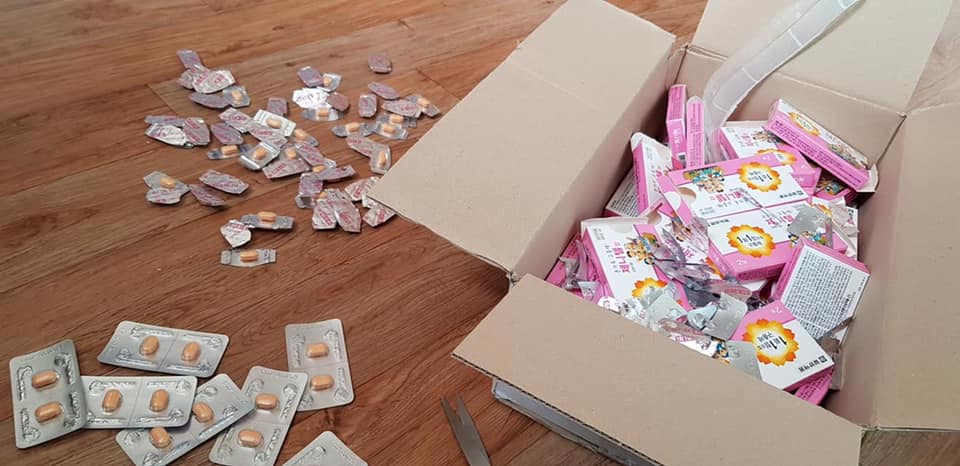
Defector-led Kuen Saem organisation and its volunteers break-up antiparasitic tablets in small portions to fit into plastic bottles. Source: Facebook
Most recently, FFNK included SD cards with the entire content of a booklet about South Korea's economic rise from a war-torn country to the current prosperity. Once connected to a mobile phone, the all-colour booklet will be showcased as a slideshow. Other recently-added items include face masks.
As for the self-proclaimed "Balloon Warrior" Lee, he releases up to 1,500 balloons a year, each carrying 30,000 of his leaflets. His materials contain the South Korean version of history on who started the Korean War and the Kim family's use of wealth such as the construction of private ski resorts amid a nationwide food shortage.
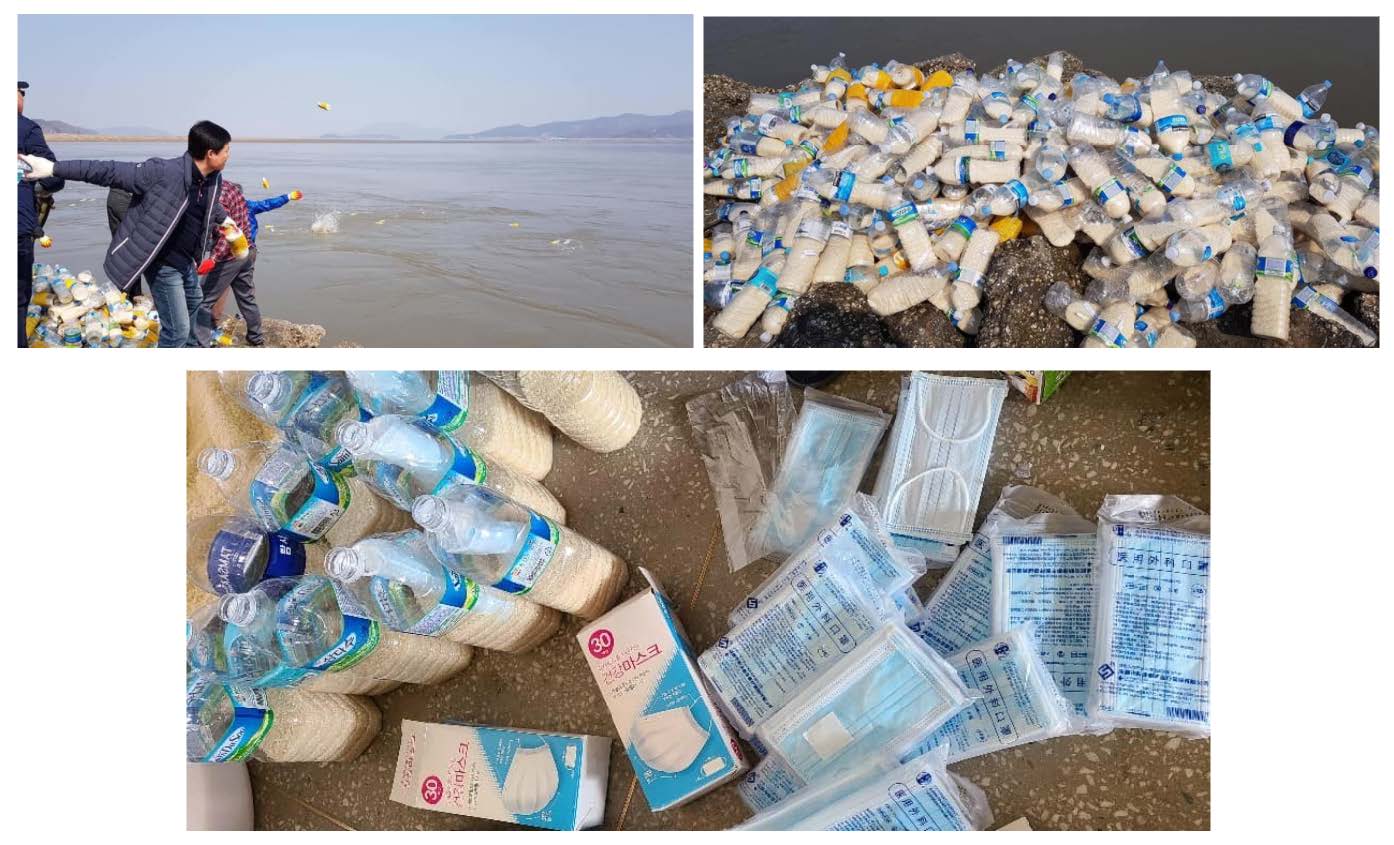
Activist group Kuen Saem sending plastic bottles filled with rice and SD cards via sea in December 2019. Source: Facebook
From Ad Balloons to Drones
The Park brothers travel to different parts of the Peninsula depending on the direction and strength of wind, precipitation and more recently, the likelihood of locals' sentiments about such activity. The aim is to get as close to the DMZ as legally possible. Some frequent locations include Baengnyeong Island, Yeonpyeong Island, Gimpo, the Ganghwa County, and more. The most frequent method is through advertising balloons using hydrogen gas, which is more affordable than helium gas, at about $30 per balloon.
At least eight people are needed to launch a hydrogen balloon as the gas tank alone can weigh about 6-70 kilograms. To send a hydrogen balloon, one needs to go through a one-week training period to receive a certificate. These balloons can be launched about six to seven months out of a year based on the region’s climate.
Recently, there has been controversy over the use of drones by Park Sang-hak's FFNK. In an interview with South Korea's ChosunBiz [2], Park claimed that he used a drone for leafleting for the first time on 9 April. South Korea’s Unification Ministry and the Ministry of National Defense were quick to counter this claim, on the basis that a commercial drone will be not able to travel some 170 km from Paju to Pyongyang. The then-Unification Minister Kim Yeon-chul also said the government has not detected such a drone activity.
Chipping Away at Theocracy
There are about a dozen South Korean, three American, and two Japanese and one British broadcasting networks, mostly radio, solely dedicated to spreading information to North Korea. So why does Pyongyang show a particularly aggressive reaction to leafleting?
As mentioned earlier, private leaflets coming from the South Korea side of the border and funded by the Korea Hana Foundation and overseas Koreans focus heavily on the North Korean leadership and this is seen as a demoralising insult for Pyongyang. When the North Korean public is exposed to detailed or even inflated and insulting information about the Kim family that are not covered by state-run media, it may lead to them questioning the nature of the North Korean government system - a de facto theocracy.
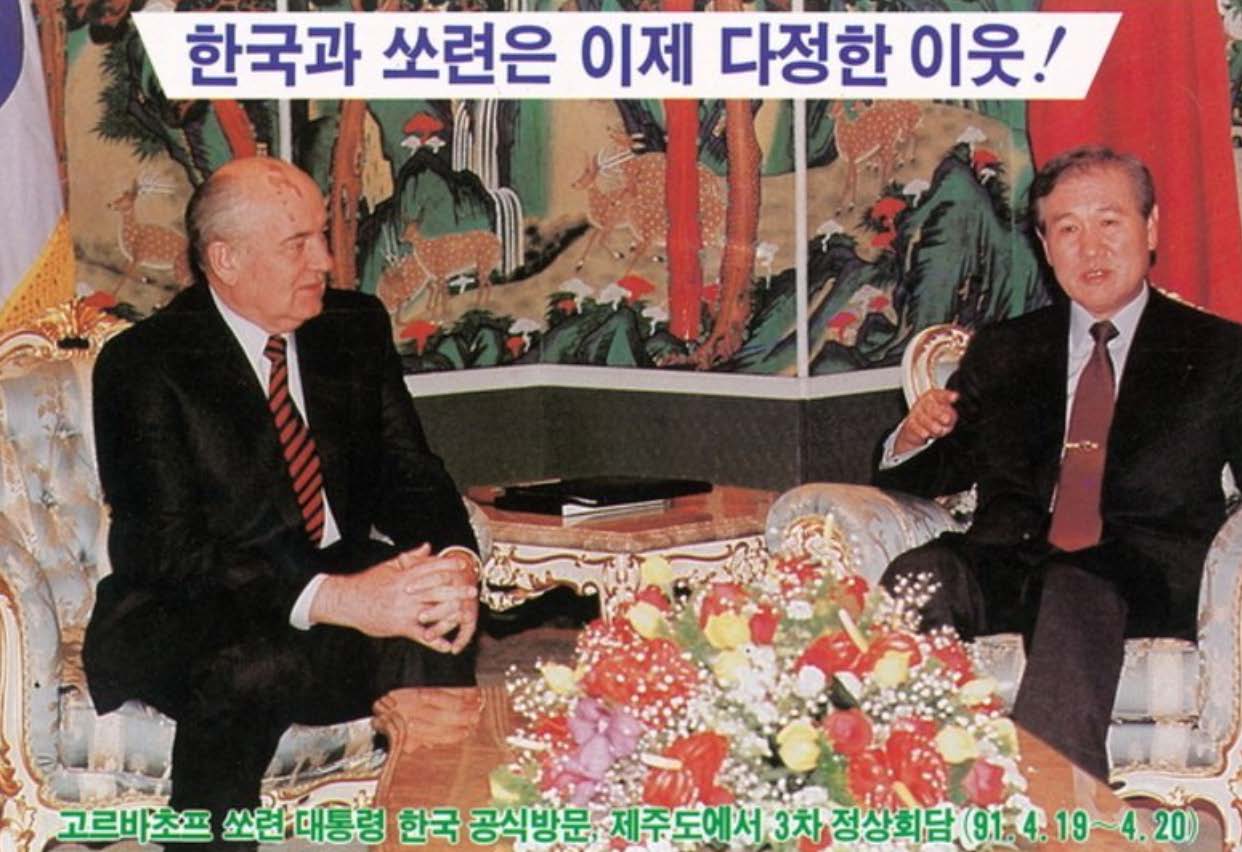
South Korean leaflets to North Korea over the years (click the link for more) Credit: DMZ Museum
Historical Context
Even though both Koreas agreed on halting propaganda leaflets in the 4 July South-North Joint Communique in 1972, they have been engaged in the activity throughout recent history. Even during the first few years of the Moon administration, South Korea sent leaflets into North Korea.
During the Roh Moo-hyun administration, the two Koreas signed the "Agreement on the Prevention of Accidental Naval Clashes in the West Sea, and the Cessation of Propaganda Activities and the Elimination of Propaganda Apparatus in the Military Demarcation Line Areas." While the name is lengthy, the agreement is basically about putting a pause on the psychological warfare along the military demarcation line by agreeing not to spread propaganda materials.
Between 3-4 June 2004, the Ministry of National Defense of the Republic of Korea (ROK) and the Ministry of the People's Armed Forces of the Democratic People's Republic of Korea (DPRK) held the second round of inter-Korean general-level military talks at Mt. Seorak. During the following working-level delegates’ meeting, the two Koreas agreed to implement the following [3]:
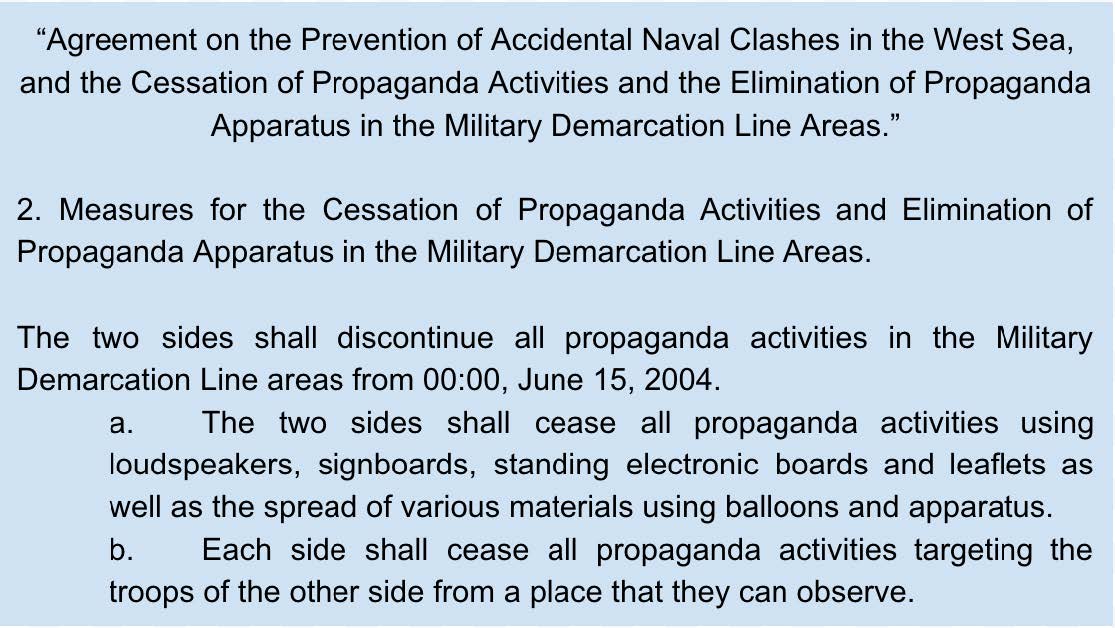
To elicit an agreement, the North made the unprecedented move to hide the Kim Il Sung statue from the South side's view along the demarcation line. However, the agreement was canceled after the North's sinking of a South Korean corvette Cheonan, on 26 March 2010.

Chun [4], who was the national security advisor during the Lee Myung-bak administration, recalls Pyongyang's repeated request to quell the propaganda leaflets and restore the 4 June agreement. North Korea even threatened to target the originating point of any propaganda leaflets by displaying artillery for the South to see. When the threats did not work, it focused more on negotiations.
Pyongyang offered to stop the slander of then-President Lee if Seoul would disallow North-bound leafleting within the Civilian Control Line, where the activity is visible and demoralising to soldiers stationed along the DMZ. South Korean negotiators declined the offer on the basis that speaking freely about anyone regardless of title is protected by the freedom of speech in the South. Instead, Chun and his team said Seoul is willing to consider the halting of leafleting if and when Pyongyang accepts responsibility for the sinking of South Korea's Cheonan. Thus, no agreement was reached.

North Korea leaflets found in South Korea (click the link for more) Credit: DMZ Museum
Most recently, the Panmunjom Declaration for Peace, Prosperity and Unification of the Korean Peninsula [5] signed on 27 April 2018 also reaffirmed the Koreas’ stance on propaganda materials including leafleting.
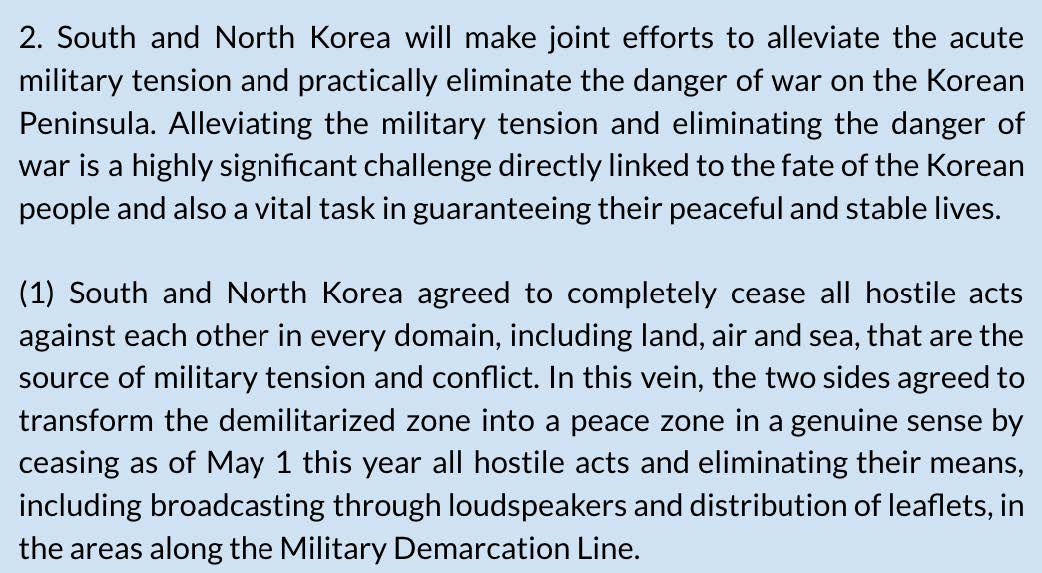
Despite the historic move, tensions have continued to rise as hopes for a substantive agreement between the U.S. and North Korea began to wane. On 16 June, the North Korean military announced it will "actively support" multi-level leafleting by different groups within the country. In stark contrast, South Korea's presidential Cheong Wa Dae has said it is making efforts to discourage the defector-led leafleting.
As of 25 June, North Korean leader Kim Jong Un decided to hold off anti-South Korea propaganda. Pyongyang removed the recently re-installed loudspeakers along the DMZ and Korea watchers widely expect the North to also scrap the leafleting plan. Last Saturday, the state-run Korean Central News Agency had said Pyongyang plans to launch 12 million anti-South Korea leaflets and some 3,000 ad balloons as "retaliatory punishment".
[1] Ministry of Unification, Ministry of Unification Position on Chosun Ilbo Report on Defector-led Organisations, 13 June 2020
[2] Son Deok-ho, 비닐코팅 전단에서 GPS드론까지 [From laminated leaflets to GPS Drone], Chosun Biz, 7 June 2020
[3] Ministry of National Defense, Defense White Paper, Republic of Korea, 2004, p. 303
[4] Chun Young-woo, Episode 52: Republic of Korea crumbling at Kim Yo Jong's intimidation, 7 June 2020, available at: https://www.youtube.com/watch?v=6J18uzzmEDs
[5] The Ministry of Foreign Affairs, Panmunjom Declaration for Peace, Prosperity and Unification of the Korean Peninsula, 2018
